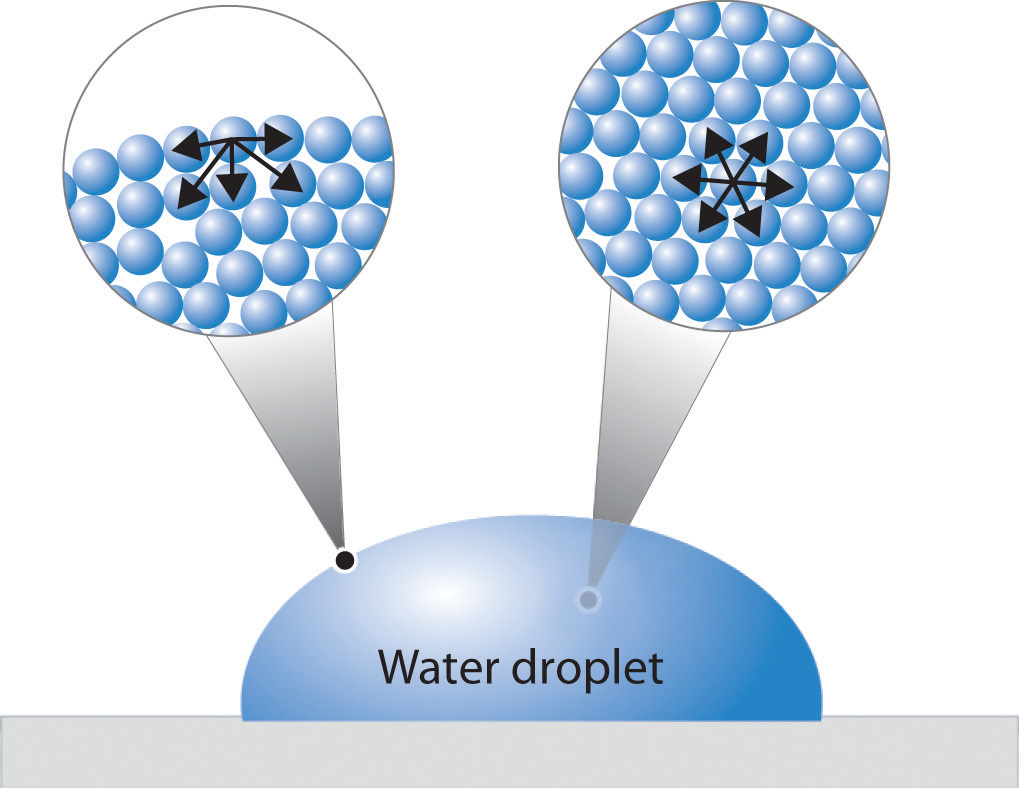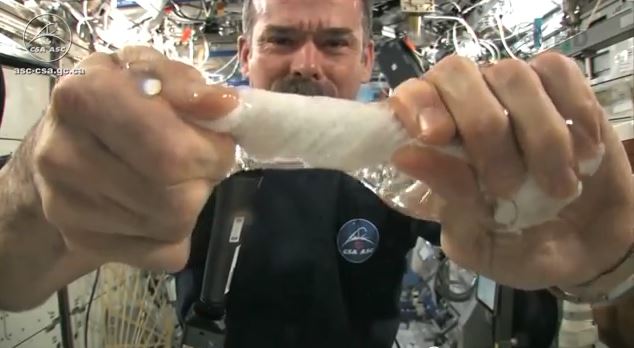
Surface Tension
 المؤلف:
LibreTexts Project
المؤلف:
LibreTexts Project
 المصدر:
................
المصدر:
................
 الجزء والصفحة:
.................
الجزء والصفحة:
.................
 28-4-2020
28-4-2020
 2144
2144
Surface Tension
If liquids tend to adopt the shapes of their containers, then, do small amounts of water on a freshly waxed car form raised droplets instead of a thin, continuous film? The answer lies in a property called surface tension, which depends on intermolecular forces. Surface tension is the energy required to increase the surface area of a liquid by a unit amount and varies greatly from liquid to liquid based on the nature of the intermolecular forces, e.g., water with hydrogen bonds has a surface tension of 7.29 x 10-2 J/m2 (at 20°C), while mercury with metallic bonds has as surface tension that is 15 times higher: 4.86 x 10-1 J/m2 (at 20°C).
Figure 1.1 presents a microscopic view of a liquid droplet. A typical molecule in the interior of the droplet is surrounded by other molecules that exert attractive forces from all directions. Consequently, there is no net force on the molecule that would cause it to move in a particular direction. In contrast, a molecule on the surface experiences a net attraction toward the drop because there are no molecules on the outside to balance the forces exerted by adjacent molecules in the interior. Because a sphere has the smallest possible surface area for a given volume, intermolecular attractive interactions between water molecules cause the droplet to adopt a spherical shape. This maximizes the number of attractive interactions and minimizes the number of water molecules at the surface. Hence raindrops are almost spherical, and drops of water on a waxed (nonpolar) surface, which does not interact strongly with water, form round beads. A dirty car is covered with a mixture of substances, some of which are polar. Attractive interactions between the polar substances and water cause the water to spread out into a thin film instead of forming beads.

Figure 1.1 : A Representation of Surface Tension in a Liquid. Molecules at the surface of water experience a net attraction to other molecules in the liquid, which holds the surface of the bulk sample together. In contrast, those in the interior experience uniform attractive forces.
The same phenomenon holds molecules together at the surface of a bulk sample of water, almost as if they formed a skin. When filling a glass with water, the glass can be overfilled so that the level of the liquid actually extends above the rim. Similarly, a sewing needle or a paper clip can be placed on the surface of a glass of water where it “floats,” even though steel is much denser than water. Many insects take advantage of this property to walk on the surface of puddles or ponds without sinking. This is even observable in the zero gravity conditions of space as shown in Figure 1.2 (and more so in the video link) where water wrung from a wet towel continues to float along the towel's surface!

Figure 1.2 : The Effects of the High Surface Tension of Liquid Water.
Such phenomena are manifestations of surface tension, which is defined as the energy required to increase the surface area of a liquid by a specific amount. Surface tension is therefore measured as energy per unit area, such as joules per square meter (J/m2) or dyne per centimeter (dyn/cm), where 1 dyn = 1 × 10−5 N. The values of the surface tension of some representative liquids are listed in Table 1.1 . Note the correlation between the surface tension of a liquid and the strength of the intermolecular forces: the stronger the intermolecular forces, the higher the surface tension. For example, water, with its strong intermolecular hydrogen bonding, has one of the highest surface tension values of any liquid, whereas low-boiling-point organic molecules, which have relatively weak intermolecular forces, have much lower surface tensions. Mercury is an apparent anomaly, but its very high surface tension is due to the presence of strong metallic bonding.
Table 1.1 : Surface Tension, Viscosity, Vapor Pressure (at 25°C Unless Otherwise Indicated), and Normal Boiling Points of Common Liquids
| Substance |
Surface Tension (× 10−3 J/m2) |
Viscosity (mPa•s) |
Vapor Pressure (mmHg) |
Normal Boiling Point (°C) |
| Organic Compounds |
| diethyl ether |
17 |
0.22 |
531 |
34.6 |
| n-hexane |
18 |
0.30 |
149 |
68.7 |
| acetone |
23 |
0.31 |
227 |
56.5 |
| ethanol |
22 |
1.07 |
59 |
78.3 |
| ethylene glycol |
48 |
16.1 |
~0.08 |
198.9 |
| Liquid Elements |
| bromine |
41 |
0.94 |
218 |
58.8 |
| mercury |
486 |
1.53 |
0.0020 |
357 |
| Water |
| 0°C |
75.6 |
1.79 |
4.6 |
— |
| 20°C |
72.8 |
1.00 |
17.5 |
— |
| 60°C |
66.2 |
0.47 |
149 |
— |
| 100°C |
58.9 |
0.28 |
760 |
— |
Adding soaps and detergents that disrupt the intermolecular attractions between adjacent water molecules can reduce the surface tension of water. Because they affect the surface properties of a liquid, soaps and detergents are called surface-active agents, or surfactants. In the 1960s, US Navy researchers developed a method of fighting fires aboard aircraft carriers using “foams,” which are aqueous solutions of fluorinated surfactants. The surfactants reduce the surface tension of water below that of fuel, so the fluorinated solution is able to spread across the burning surface and extinguish the fire. Such foams are now used universally to fight large-scale fires of organic liquids.
 الاكثر قراءة في اخرى
الاكثر قراءة في اخرى
 اخر الاخبار
اخر الاخبار
اخبار العتبة العباسية المقدسة


